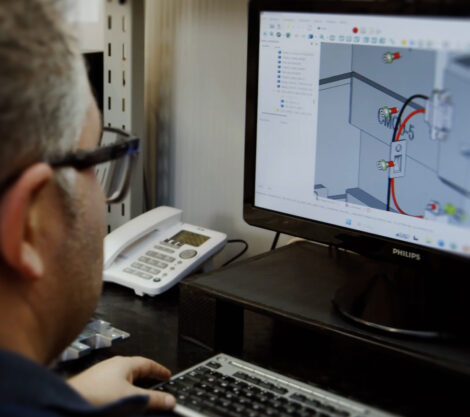Mechanical Engineering
Despite being part of a small and relatively young company, SAB Aerospace engineers hold their own in developing complete systems from specification to final delivery.
SAB’s design capabilities led to a partnership with OHB System AG established in 2010 that allowed SAB engineers to participate in the mechanical development of some of the most important OHB projects, like EDRS-C, Galileo FOC, and ExoMars 2016. This has helped cement SAB’s experience in full aluminium and CFRP platforms.
This partnership afforded SAB Aerospace the opportunity to grow its abilities by working on several high-profile ESA projects.
The mechanical integrity of spacecraft relies on structure subsystems able to withstand handling stresses, launch loads, flight in freefall and propulsion. The challenge aerospace engineers have always faced is limiting mass while maintaining stability and increasing strength. Innovative use of materials, intelligent design and advanced manufacturing all contribute to achieving this fine balance.
Satellite buses are the main structural component of satellites. They house delicate modules internally and act as frames for external structures like the solar panels that power the satellites, telemetry electronics and other equipment. The bus defines the shape of the satellite and is the structure to which the other subsystems are attached.
The mass of a spacecraft structure’s subsystems should generally be less than 10% of the spacecraft’s entire mass, and yet it is required to withstand mechanical loads equivalent to 50 to 100 times their weight during launch. Demanding engineering challenges must be confronted in the design of spacecraft to ensure maximum stability and strength while minimising mass.
Modelling complex mechanical forces in the initial design is the key to predicting the static and dynamic behaviour of the final product. Mechanical distortions resulting from changing temperature fields in orbit also require simulation so solutions can be modelled and built into the end design.
Producing sophisticated designs based on the results of numerical simulations is the core of our design and development expertise at SAB Aerospace.
SAB engineers use a suite of highly specialised computer-aided design software like Unigraphics NX to produce designs. Progressive ideations of the designs are honed to perfection using simulation software packages like MsC, NASTRAN, HyperMesh and Optistruct.
Thermal Engineering
The services offered by SAB Aerospace begin with a detailed analysis of the thermal flux the components will experience and end with the design and verification of the complete thermal subsystem. SAB’s thermal design activities are concentrated along the following axes:
Thermal Modelling and Thermal Control
Satellites must withstand the extreme cold of space and the intense heat of the solar flux outside the Earth’s atmosphere. Engineering for these temperature extremes is a fundamental challenge for satellite developers. Added to these external thermal stresses are a spacecraft’s own heat-producing subsystems used to generate power and the significant aerodynamic heating experienced by the payload fairing as it is launched out of the Earth’s atmosphere at several times the speed of sound.
Designing for these challenges requires thermal analysis and the accurate modelling of heat sources, heat sinks, radiative processes and convective heat exchange processes in the components. The models must consider the design of the system, its materials, surface properties, and heat dissipation by equipment. SAB uses advanced software tools — SINDA/Fluint, Thermal Desktop/RADCAD and ESATAN TMS — to simulate the heat exchange, and the final design ensures that the components meet and exceed thermal requirements, so payloads survive launch and remain in perfect working order throughout their operational lives.



